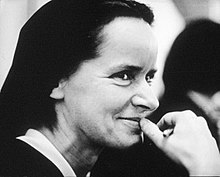Sister Corita
| Corita Kent | |
|---|---|
 |
|
| Born |
Frances Elizabeth Kent November 20, 1918 Fort Dodge, Iowa |
| Died | September 18, 1986 (aged 67) Boston, Massachusetts |
| Known for | Silkscreen, serigraphy |
| Movement | Pop art |
Corita Kent (November 20, 1918 – September 18, 1986), aka Sister Mary Corita Kent, was born Frances Elizabeth Kent in Fort Dodge, Iowa. Kent was an American Catholic nun, artist, and educator who lived and worked in Los Angeles and Boston.
She worked almost exclusively with silkscreen, also known as serigraphy, pushing back the limitations of the two-dimensional medium by the development of innovative methods. Kent's emphasis on printing was partially due to her wish for democratic outreach, as she wished for affordable art for the masses. Her artwork, with its messages of love and peace, was particularly popular during the social upheavals of the 1960s and 1970s. After a cancer diagnosis in the early 1970s, she entered an extremely prolific period in her career, including Rainbow Swash design on the LNG storage tank in Boston, and the 1985 version of the United States Postal Service's special Love stamp.
In recent years, Corita has gained increased recognition for her role in the Pop Art movement. Critics and theorists previously failed to count her work as part of any mainstream "canon," but in the last few years there has been a resurgence of attention given to Kent. As both a nun and a woman making art in the twentieth century, she was in many ways cast to the margins of the different movements she was a part of.
Corita's art was her activism, and her spiritually-informed social commentary promoted love and tolerance.
Frances Elizabeth Kent was born in Fort Dodge, Iowa in 1918. Upon entering the Roman Catholic order of Sisters of the Immaculate Heart of Mary in Los Angeles in 1936, Kent took the name Sister Mary Corita. She took classes at Otis (now Otis College of Art and Design) and Chouinard Art Institute and earned her BA from Immaculate Heart College in 1941. She earned her MA at the University of Southern California in Art History in 1951. Between 1938 and 1968 Kent lived and worked in the Immaculate Heart Community. She taught in the Immaculate Heart College and became the chair of its art department in 1964. Her classes at Immaculate Heart were an avant-garde mecca for prominent, ground-breaking artists and inventors, such as Alfred Hitchcock, John Cage, Saul Bass, Buckminster Fuller and Charles & Ray Eames. Kent credited Charles Eames, Buckminster Fuller, and art historian Dr. Alois Schardt for their important roles in her intellectual and artistic growth. By the early 1950s, she had such a unique and well-known aesthetic and teaching style that clergy members from all over the country were sent to be educated at Immaculate Heart College. Her students were drawn to her selflessness and unique teaching methods such as large class assignments like asking students to create 200 drawings or take three hours to draw their arm without looking at what they were creating. She toured widely the following decade. After the Second Vatican Council, Kent transformed Immaculate Heart College’s annual Mary’s Day procession into a community celebration which was part of the sister’s campaign to bring secular people together. During this time, Kent’s work became increasingly political, addressing events such as the Vietnam War and humanitarian crises. For example, she was commissioned by the Physicians for Social Responsibility to create what she called “we can create life without war” billboards. Tensions between the order and church leadership were mounting, with the Los Angeles archdiocese criticizing the college as “liberal” and Cardinal James McIntyre labeling the college as “communist” and Kent’s work as “blasphemous.” Due to this, Kent returned to secular life in 1968 as Corita Kent. Most sisters followed suit and the Immaculate Heart College closed in 1980.
...
Wikipedia
